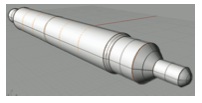Passenger submarine concept design for oil production offshore systems
DOI:
https://doi.org/10.25043/19098642.42Keywords:
passenger submarine concept design, Manpower flow in offshore systems, CFD analysisAbstract
The paper proposes an innovative solution to transport workers of offshore oil production platforms from the coast to their units, which operate at the Pre-Salt exploration, 300 km from the coast. A passenger submarine concept design was developed, justified by the range of practical obstacles observed in the current modes of transportation, helicopters and supply boats. Requirements like operational depth (100 m), passenger capacity (250 people), and cruising speed (minimum 13.4 knots) are defined, based on estimates. Firstly, it seeks the adoption of air-independent propulsion (AIP) systems, by fuel cells (PEMFC). However, the work progress leads to an entire electric propulsion system. The internal arrangement is elaborated, regarding passenger comfort, structural constraints, allocation of batteries and ballast tanks. Then, after a hydrodynamic hull optimization, by Computational Fluid Dynamics analysis, we provide a final configuration with 100-m length and 9.7-m diameter, operational speed of 16 kt, and autonomy of 26 hours.Downloads
References
ABS (American Bureau of Shipping). Rules for building and classing underwater vehicles, systems and hyberbaric facilities. 2010.
ADAMS, V. W. Possible fuel cell applications for ships and submarines. Journal of Power Resources. 1990. Vol 29. PP. 181-192.
GABLER, U. Submarine Design. 1ª ed. São Paulo. AMRJ/ETCN. 1991.
JACKSON, H. A. Fundamentals of Submarine Concept Design. SNAME Transactions. 1992. Vol 100. pp. 419-448.
NEWMAN, J. N. Marine Hydrodynamics. The Massachusetts Institute of Technology. 1977.
PRINS, C. A., EVERARD B., Approaches to submarine design in a changing environment. INEC. 1996. Paper 3.

Published
How to Cite
Issue
Section
License
The authors who publish in this Journal certify that:
- The work submitted for publication in The Ship Science and Technology journal, was written by the author, given that its content is the product of his/her direct intellectual contribution.
- All data and references to material already published are duly identified with their respective credits and are included in the bibliographic notes and quotations highlighted as such.
- All materials submitted for publication are completely free of copyrights; consequently, the author accepts responsibility for any lawsuit or claim related with Intellectual Property Rights thereof, Exonerating of responsibility to The Science and Technology for the Development of Naval, Maritime, and Riverine Industry Corporation, COTECMAR.
- In the event that the article is chosen for publication by The Ship Science and Technology journal, the author state that he/she totally transfers reproduction rights of such to The Science and Technology for the Development of Naval, Maritime, and Riverine Industry Corporation, COTECMAR.
- The authors retain the copyright and transfer to COTECMAR the right of publication and reproduction of the work which will be simultaneously subject to the Creative Commons Attribution License (CC -BY) , which allows the license to copy, distribute, display and represent the work and to make derivative works as long as it recognizes and cites the work in the manner specified by the author or licensor.
- For more information about the Creative Commons Attribution License (CC -BY) and his use and scope, please visit the following web page https://creativecommons.org/licenses/by-sa/4.0/legalcode








